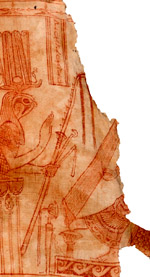Center, Textile Research

Egyptian Textiles and Their Production: ‘Word’ and ‘Object’
Date of this Version
3-2-2020
Document Type
Book Chapter
Citation
Published in Maria Mossakowska-Gaubert, ed., Egyptian Textiles and Their Production: ‘Word’ and ‘Object’ (Hellenistic, Roman and Byzantine Periods) (Lincoln, NE: Zea Books, 2020).
doi 10.32873/unl.dc.zea.1086
Abstract
The complex chaîne opératoire of ancient textile production in various stages has been frequently discussed by textile scholars. According to documentary papyri, textile manufacturing represented the highest taxed industry after agriculture. This emphasises its importance as a significant sector in the ancient economy. A highly specialised branch within the chaîne opératoire is the dyeing industry. Ancient dyers used natural and animal dyestuffs, as well as different dyeing techniques to achieve their colourful results. They were also aware of the specific properties of the different textile fibres. In ancient times, wool and linen were the characteristic materials for manufacturing textiles, but archaeological and papyrological sources further attest the use of cotton, silk and even goat hair. Depending on the particular fibre properties and the natural pigmentation, different results, colours and hues could be achieved. Preserved textiles show that mainly wool was dyed, but there are dyed linen textiles as well.
The present paper aims to examine the outstanding mastery, skills and practical knowledge that are seen in both Greek documentary papyri and preserved late antique textiles. 5 We also would like to point out an indicative modus operandi to determine ancient technology.
Included in
Africana Studies Commons, African Languages and Societies Commons, Classical Archaeology and Art History Commons, Fiber, Textile, and Weaving Arts Commons, History of Art, Architecture, and Archaeology Commons, History of Science, Technology, and Medicine Commons


Comments
Copyright © 2020 Ines Bogensperger & Helga Rösel-Mautendorfer